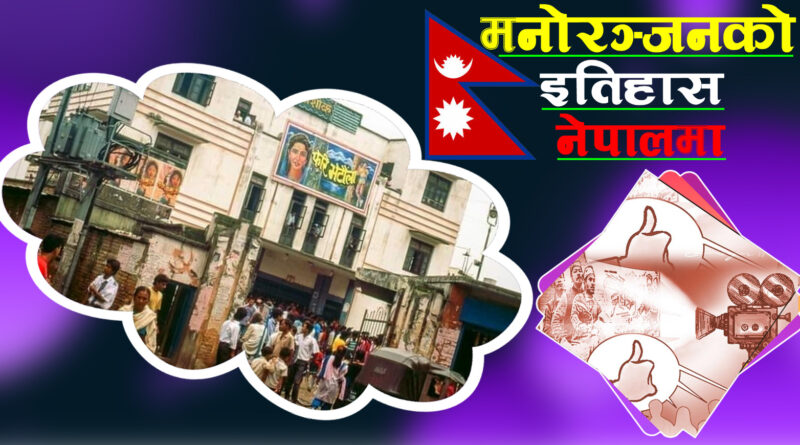नेपालको मनोरञ्जन क्षेत्रको विकासक्रम
नेपालको मनोरञ्जन क्षेत्रको विकासक्रम – देशको सामाजिक, सांस्कृतिक रूपान्तरण, सिर्जनात्मकता र धैर्यताको प्रतिबिम्ब हो। लोकगीत, पौराणिक कथावाचन र परम्परागत नाचगानबाट सुरु भएको यो यात्रा आज डिजिटल युगसम्म आइपुगेको छ । जहाँ चलचित्र, रेडियो, टेलिभिजन सिरियल, युट्युब र ओटीटी प्लेटफर्महरू नेपाली मनोरञ्जनको अभिन्न अंश बनेका छन्।
सन् १९५१ मा पहिलो नेपाली चलचित्र निर्माण भएको थियो भने सोही वर्ष रेडियो नेपाल सुरु गरिएको थियो। टेलिभिजन भने १९८४ मा सुरु भएको हो। यी माइलस्टोनहरूले आधुनिक नेपाली सञ्चार र जनसांस्कृतिक जग बसालेका छन्।
यो लेखले नेपाली मनोरञ्जन क्षेत्रको विस्तृत इतिहास प्रस्तुत गर्दै चलचित्र, सिरियल, संगीत, रेडियो र डिजिटल मिडियाको विकासक्रम, प्रमुख उपलब्धिहरू, प्रविधिको परिवर्तन, संस्थागत योगदान र भविष्यको सम्भावनाहरू समेटेको छ।
The evolution of Nepal’s entertainment industry is a reflection of the country’s socio-cultural transformation, creativity, and resilience. From the early days of folk performances, religious storytelling, and classical music to the emergence of a structured film industry, radio broadcasting, television serials, and the recent digital revolution — Nepali entertainment has journeyed through seven decades of growth, challenges, and innovation.
Nepal’s first film was released in 1951, while radio started in the same year and television arrived in 1984. These milestones shaped the foundation of modern Nepali media and pop culture. Over time, the rise of comedy serials, musical legends, and internet-based creators added depth and diversity to the industry. Today, the Nepali entertainment world includes mainstream cinema, YouTube serials, social media influencers, podcasts, and OTT platforms.
This article provides a detailed timeline and analysis of the development of films, serials, radio, music, and digital entertainment in Nepal — highlighting major achievements, artists, technological shifts, institutional support, and future opportunities.
History and Development of Entertainment Industry, Film & Serial in Nepal
Timeline: 1950s to Present
Traditional Entertainment in Nepal (नेपालको मनोरञ्जन क्षेत्रको विकासक्रम)
Before the emergence of modern media, Nepali entertainment was deeply rooted in culture, tradition, and
religion.
Traditional forms included:
– Lok Dohori (folk duets)
– Ghatu, Sorathi, Deuda (regional cultural dances)
– Newar drama (Gaan) performances in festivals and Jatras
– Storytelling traditions such as “Katha” during religious gatherings
– Classical music linked with Hindu and Buddhist rituals
Nepali Film Industry (Kollywood) – नेपालको मनोरञ्जन क्षेत्रको विकासक्रम
A. First Phase: Origins (1951–1990)
1951: “Satya Harishchandra” – First Nepali-language movie (produced in India by D. B. Pariyar)
1964: “Aama” – First Nepali feature film produced in Nepal by the Department of Information
1971: “Maitighar” – First private-sector movie; introduced actors like Mala Sinha and Chidambar Prasad Lohani
These early movies were patriotic, moral, and culturally symbolic.
➡ Early Themes: Nationalism, sacrifice, cultural harmony
➡ Production challenges: No studios, limited cameras, government-led production
B. Second Phase: Golden Age (1990–2005)
With political liberalization and the rise of democracy: – Private production houses emerged – Films like
Kusume Rumal, Chino, Balidan, Darpan Chhaya gained cult status
Popular actors: Bhuwan K.C., Tripti Nadakar, Niruta Singh, Rajesh Hamal
Technological Growth: Films began using better cameras and sound design.
➡ Increased cinema halls, fan following, and urban appeal
C. Third Phase: Digital and New Wave (2006–present)
2006 onwards: Digital cameras and editing tools made filmmaking cheaper and accessible
2012: “Loot” redefined Nepali cinema with realistic storytelling and urban youth themes
More genres: thriller, horror, sci-fi, romance
Notable Films: Kabaddi series, Pashupati Prasad, The Red Suitcase, Bulbul, Chiso Ashtray
➡ Rise of independent directors and screenwriters
➡ International recognition at global film festivals
Nepali Television and Serials (नेपालको मनोरञ्जन क्षेत्रको विकासक्रम)
A. Birth of Television:
1984: Nepal Television (NTV) began as the country’s first national broadcaster. First broadcasts included government news, educational programs, and cultural shows.
B. Rise of Nepali Serials:
Late 1980s to 1990s: Rise of drama serials adapted from radio stories.
Early successful serials: Halchal, Dui Thopa Aansu, Aama
2000s–2010s: Golden Era of Comedy Serials
Tito Satya, Jire Khursani, Meri Bassai, Bhadragol became staples of Nepali households – Comedy blended
with social satire became popular
Recent Trends: – Rise of YouTube-based serials (e.g. Sakkigoni, Gharbeti Ba) – Private channels like Kantipur
TV, Image Channel, AP1 introducing serials and reality shows
Social media platforms have democratized serial production
Radio & Music Entertainment (नेपालको मनोरञ्जन क्षेत्रको विकासक्रम)
A. Radio Nepal:
1951: Radio Nepal established
Early entertainment included:
Radio drama (Shrutisambeg, Katha Mitho Sarangiko)
Dohori programs
Educational and cultural shows
Red FM, Image FM, Kantipur FM later diversified content with pop music, interviews, and live shows.
B. Music Industry:
Early music was recorded in India due to lack of studios
Nati Kaji, Ambar Gurung, Aruna Lama were pioneers
1974 AD, Cramps, The Shadows, Nabin K. Bhattarai revolutionized the industry in 90s–2000s
YouTube and digital platforms reshaped distribution and promotion post-2010
Now music is a mainstream industry with concerts, streaming, and cross-border appeal (नेपालको मनोरञ्जन क्षेत्रको विकासक्रम)
Digital Revolution in Entertainment (नेपालको मनोरञ्जन क्षेत्रको विकासक्रम)
Post-2010: YouTube, TikTok, Instagram changed content creation and distribution
Nepali vloggers, comedians, musicians found new platforms
OTT platforms like OSR Digital, CineSansar, and Reel On emerging
Podcasts, reaction videos, and digital serials gaining momentum
➡ Anyone with a smartphone can be a creator or viewer
Institutional & Economic Impact (नेपालको मनोरञ्जन क्षेत्रको विकासक्रम)
Film Development Board (FDB) promotes policy and subsidies
Hundreds of production houses registered
Entertainment industry supports:
Cinemas, advertisement, technicians, editors, musicians, actors
Annual film awards: NFDC Awards, NEFTA, National Film Awards
Estimated economic contribution: NPR 5–7 billion annually (informal estimate)
➡ A source of employment, tourism promotion, and cultural export
Challenges and Opportunities (नेपालको मनोरञ्जन क्षेत्रको विकासक्रम)
Challenges: – Piracy and copyright violations – Limited funding and government support – Lack of
professional training institutes – Political interference in media policies
Opportunities: – Vast youth talent pool – Diaspora market (NRNs) – Untapped genres: animation,
documentary, fantasy – International film co-productions and festival entries
Conclusion (नेपालको मनोरञ्जन क्षेत्रको विकासक्रम)
From traditional storytelling to TikTok, Nepal’s entertainment journey spans seven decades of cultural
evolution, social influence, and creative expansion. Despite many challenges, the sector has shown
resilience and growth through talent, technology, and audience support.

